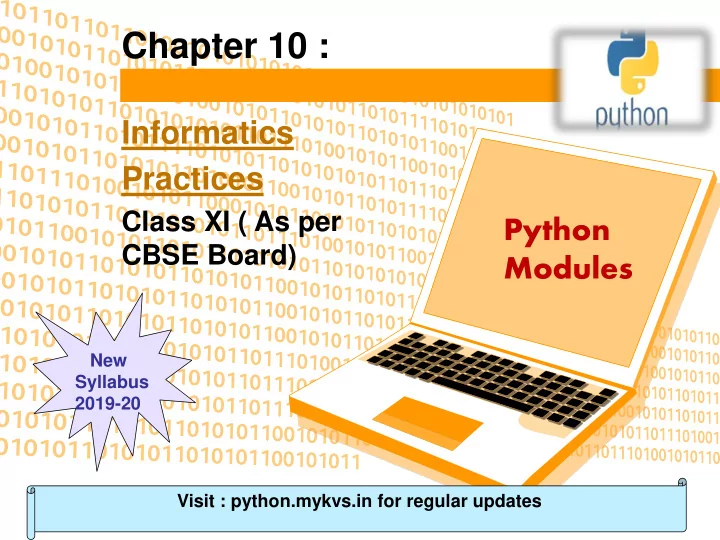

Chapter 10 : Informatics Practices Class XI ( As per Python CBSE Board) Modules New Syllabus 2019-20 Visit : python.mykvs.in for regular updates
Python Module A module is a logical organization of Python code. Related code are grouped into a module which makes the code easier to understand and use. Any python module is an object with different attributes which can be bind and referenced. Simply, it is a file containing a set of functions which can be included in our application. Python provide inbuilt standard modules, like math, random etc. Visit : python.mykvs.in for regular updates
math module math module The math module is a standard module in Python and is always available. To use mathematical functions under this module, you have to import the module using import math. How to use math function import math math.sqrt(4) Visit : python.mykvs.in for regular updates
math module math.sqrt() The math.sqrt() method returns the square root of a given number. >>>math.sqrt(100) 10.0 >>>math.sqrt(3) 1.7320508075688772 The ceil() function approximates the given number to the smallest integer, greater than or equal to the given floating point number. The floor() function returns the largest integer less than or equal to the given number. >>>math.ceil(4.5867) 5 >>>math.floor(4.5687) 4 math.pow() The math.pow() method receives two float arguments, raises the first to the second and returns the result. In other words, pow(2,3) is equivalent to 2**3. >>>math.pow(2,4) 16.0 Visit : python.mykvs.in for regular updates
math module math.fabs() Returns the absolute value of x >>> import math >>> math.fabs(-5.5) 5.5 The math module contains functions for calculating various trigonometric ratios for a given angle. The functions (sin, cos, tan, etc.) need the angle in radians as an argument. >>> math.sin(270) -0.1760459464712114 Visit : python.mykvs.in for regular updates
Random Module Random Module The random module provides access to functions that support many operations.Perhaps the most important thing is that it allows us to generate random numbers. random.randint() Randint accepts two parameters: a lowest and a highest number. import random print (random.randint(0, 5)) This will output either 1, 2, 3, 4 or 5. random.random() Genereate random number from 0.01 to 1.If we want a larger number, we can multiply it. import random print(random.random() * 100) Visit : python.mykvs.in for regular updates
Random Module randrange() generate random numbers from a specified range and also allowing rooms for steps to be included. Syntax : random.randrange(start(opt),stop,step(opt)) import random # Using randrange() to generate numbers from 0-100 print ("Random number from 0-100 is : ",end="") print (random.randrange(100)) # Using randrange() to generate numbers from 50-100 print ("Random number from 50-100 is : ",end="") print (random.randrange(50,100)) # Using randrange() to generate numbers from 50-100 # skipping 5 print ("Random number from 50-100 skip 5 is : ",end="") print (random.randrange(50,100,5)) OUTPUT Random number from 0-100 is : 27 Random number from 50-100 is : 48 Random number from 50-100 skip 5 is : 80 Visit : python.mykvs.in for regular updates
statistics module statistics module This module provides functions for calculating mathematical statistics of numeric (Real-valued) data. statistics.mean(data) Return the sample arithmetic mean of data which can be a sequence or iterator.The arithmetic mean is the sum of the data divided by the number of data points(AVERAGE). import statistics print(statistics.mean([5,3,2])) OUTPUT 3.3333333333333335 statistics.median(data) Return the median (middle value) of numeric data, using the common “mean of middle two” method. If data is empty, StatisticsError is raised. import statistics print(statistics.median([5,5,4,4,3,3,2,2])) OUTPUT 3.5 Visit : python.mykvs.in for regular updates
statistics module statistics.mode(data) Return the most common data point from discrete or nominal data. The mode (when it exists) is the most typical value, and is a robust measure of central location.If data is empty, or if there is not exactly one most common value, StatisticsError is raised. import statistics print(statistics.mode([1, 1, 2, 3, 3, 3, 3, 4])) OUTPUT 3 Visit : python.mykvs.in for regular updates
Recommend
More recommend